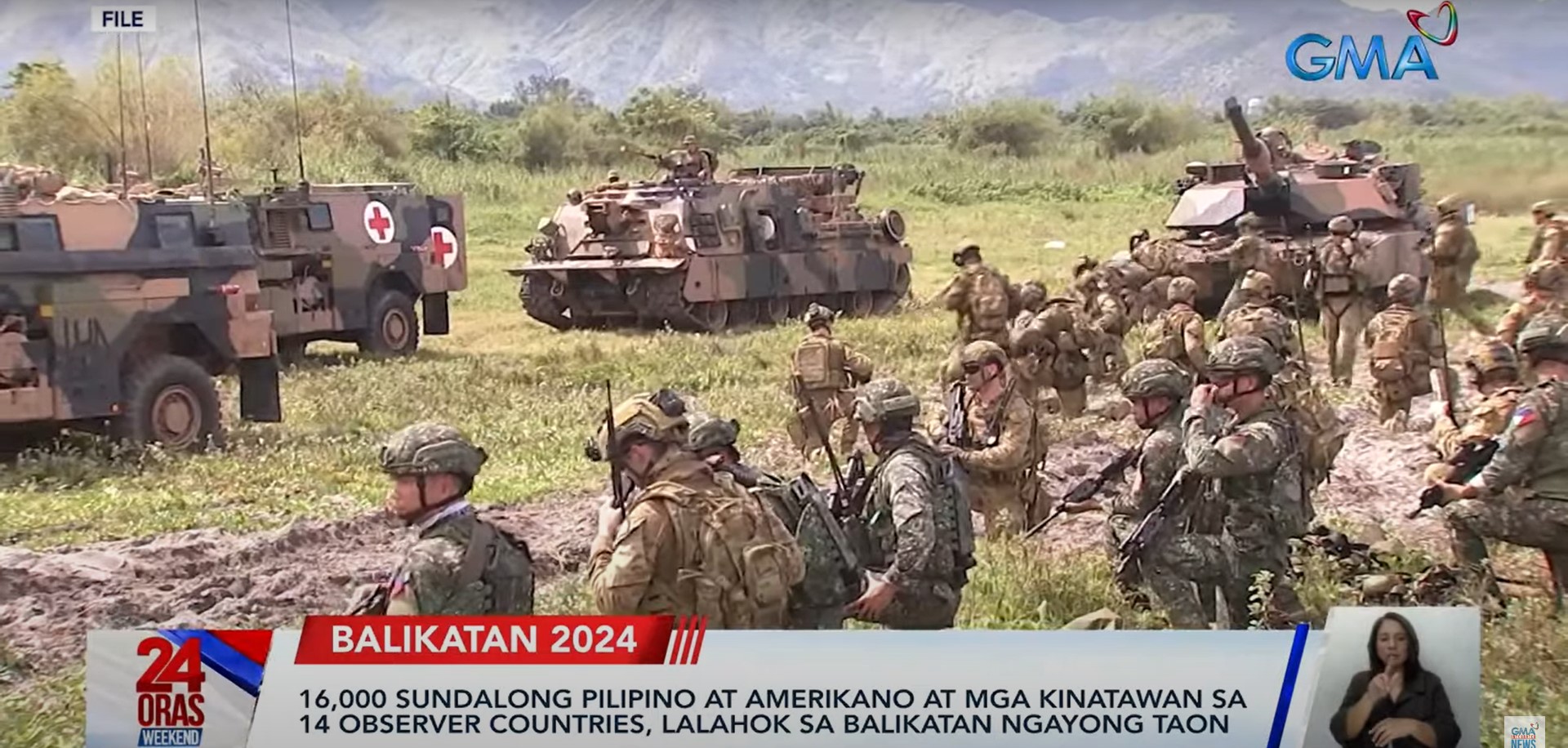


The Balikatan joint military exercise between the Philippines and the United States, dubbed as the biggest iteration to date with some 16,700 troops, is scheduled to begin on Monday, April 22, 2024.
The 39th Balikatan, said to be the biggest in four decades, will be held from April 22 to May 10 in Palawan and Batanes, close to Taiwan and the South China Sea, both areas being claimed and monitored by China.
“Lahat po ng available na assets ng Philippine Army ay gagamitin natin para makita natin ‘yung interoperability nito sa lahat ng major service,” Philippine Army spokesperson Col. Louie Dema-ala said in an interview on GMA Super Radyo DZBB aired on 24 Oras Weekend on Sunday.
“Tinitignan natin kung in line ba ito sa mga current SOPs (standard operating procedures), ‘yung TTPs natin, ‘yung tactics, techniques, and procedures ‘pag dating sa combat operations,” he added.
(All the available assets of the Philippine Army will be used so we can see the interoperability in all major services… We will see if this is in line with the current SOPs, the TTPs when it comes to combat operations.)
This year’s Balikatan is set to involve exercises on command and control, and field training, as well as humanitarian civic assistance. Parties will also conduct a multilateral maritime exercise or joint sailing exercise in the Philippines’ exclusive economic zone (EEZ).
This will also involve personnel from the Australian Defense Force and the Marine Nationale (French Navy), along with the participation of government agencies such as the Philippine Coast Guard (PCG), the Philippine National Police (PNP), the Department of Information, Communications, and Technology (DICT), the Office of Civil Defense (OCD), and the Presidential Communications Office (PCO).
The exercise will also have observers from 14 countries: Brunei, Canada, France, Germany, Great Britain, India, Indonesia, Japan, Malaysia, New Zealand, Singapore, South Korea, Thailand and Vietnam.
“Nagco-coincide ‘to, ‘yung shift natin, adoption ng ating gobyerno, ‘yung comprehensive defense concept,” Security Analyst and professor Renato De Castro said in the same 24 Oras Weekend report.
(This coincides — our shift, the adoption of our government, the comprehensive defense concept.)
“Kasi the Armed Forces of the Philippines has been gearing up for what we call external defense, and of course, very specific ‘to not, it’s defending the Philippine archipelago,” he added.
Leaders of the Philippines, the United States, and Japan earlier this month released a Joint Vision Statement indicating the possibility of more combined naval training and exercises together, with Manila set to receive support for its defense modernization priorities.
The Joint Vision Statement also reiterated the countries’ “serious concerns” over China’s “dangerous and aggressive” behavior in the South China Sea, as the leaders cited the 2016 Arbitral Ruling that states the Ayungin Shoal — a submerged reef among the Spratly Islands — lies within the Philippine EEZ.
Prior to this, naval and air forces of the three countries and Australia conducted a multilateral maritime cooperative activity (MMCA) in the West Philippine Sea, in line with their commitment to strengthen regional and international cooperation.
This comes as China has refused to acknowledge the Permanent Court of Arbitration’s ruling that invalidated its so-called ”nine-dash line”. Its government earlier said it will continue to adhere to what it described as a “friendly consultation” with the Philippines after several Chinese vessels have been found “swarming” areas in the West Philippine Sea.
The China Coast Guard on March 23 water cannoned a Philippine resupply ship en route to the Ayungin Shoal, causing heavy damage and hurting Filipino sailors. It was on a mission to provide supplies to the decrepit Navy vessel the BRP Sierra Madre that has been aground in the country’s outpost in the area.—Jon Viktor Cabuenas/RF, GMA Integrated News